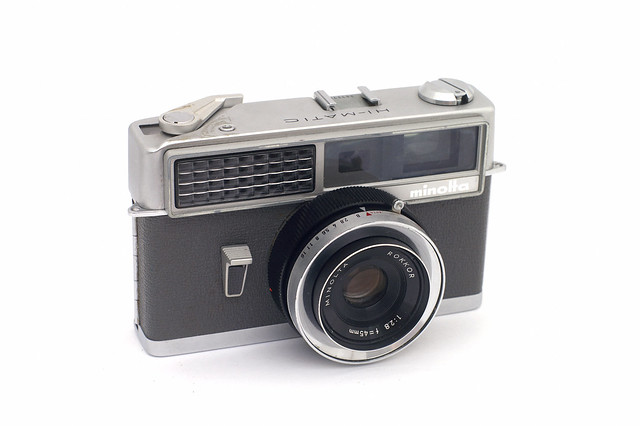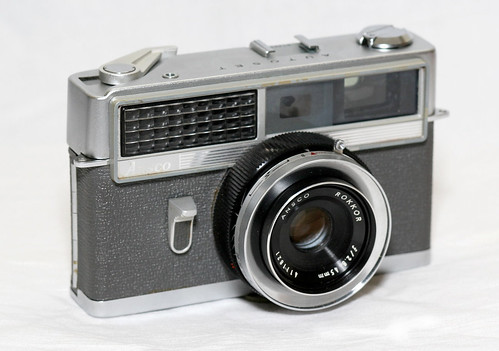Difference between revisions of "Minolta Hi-Matic"
(deleted some markup that seemed funky; adding pic of Ansco variant; smoothing clumsy phrasing) |
(noting overlaps with Uniomat; two footnotes which somewhat debunk the John Glenn "Ansco from the drugstore" myth) |
||
| Line 7: | Line 7: | ||
|image_rights= non-commercial | |image_rights= non-commercial | ||
}} | }} | ||
| − | The '''Minolta Hi-Matic''' camera redefined [[Minolta]]'s series of budget [[rangefinder camera]]s, | + | The '''Minolta Hi-Matic''' camera redefined [[Minolta]]'s series of budget [[rangefinder camera]]s, although they overlapped with the less-advanced [[Minolta Uniomat|Uniomat II]] and [[Minolta Uniomat|Uniomat III]]. The Hi-Matics always had a fully-automatic exposure mode. The original Hi-Matic model controlled this via a [[selenium meter]], and offered a flash mode with shutter speed 1/30 sec. and manual aperture control. This model became famous in its [[Ansco]] OEM version, the '''Ansco Autoset''', as one of the cameras that Astronaut John Glenn used during his space flight<REF> Glenn used a modified Leica for pictorial images: [http://www.nasm.si.edu/collections/artifact.cfm?id=A19670198000 "Another Journey for John Glenn’s Ansco Camera"] (May 27, 2011) blog post from [http://blog.nasm.si.edu/ Smithsonian National Air & Space Museum]</REF><REF>The Ansco was modified by NASA with a pistol grip and optics to make UV spectrographs, not pictorial images: [http://www.nasm.si.edu/collections/artifact.cfm?id=A19670198000 "Camera, Spectrographic, 35mm, Glenn, Friendship 7"] in the collection of the [http://www.nasm.si.edu/ Smithsonian National Air and Space Museum].</REF> |
Later Hi-Matics had [[CdS]] meters (beginning with the [[Minolta Hi-Matic 7|Hi-Matic 7]]), with the meter cell always placed within the filter ring. | Later Hi-Matics had [[CdS]] meters (beginning with the [[Minolta Hi-Matic 7|Hi-Matic 7]]), with the meter cell always placed within the filter ring. | ||
| Line 24: | Line 24: | ||
===Later variant=== | ===Later variant=== | ||
* Lens: 1:2.8/45mm (4 elements) | * Lens: 1:2.8/45mm (4 elements) | ||
| + | |||
| + | {{br}} | ||
| + | ==Links== | ||
| + | <references/> | ||
Revision as of 16:49, 16 September 2011

|
| Standard-setting 1962 rangefinder image by Steve Harwood (Image rights) |
The Minolta Hi-Matic camera redefined Minolta's series of budget rangefinder cameras, although they overlapped with the less-advanced Uniomat II and Uniomat III. The Hi-Matics always had a fully-automatic exposure mode. The original Hi-Matic model controlled this via a selenium meter, and offered a flash mode with shutter speed 1/30 sec. and manual aperture control. This model became famous in its Ansco OEM version, the Ansco Autoset, as one of the cameras that Astronaut John Glenn used during his space flight[1][2]
Later Hi-Matics had CdS meters (beginning with the Hi-Matic 7), with the meter cell always placed within the filter ring.
Specifications
- Type: rangefinder camera
- Manufacturer: Minolta
- Year of launch: 1962
- Film: 35mm with speeds from 6 to 1600 ASA
- Lens: 1:2.0/45mm (6 elements in 5 groups)
- Shutter: Citizen leaf shutter with meter-controlled aperture/speed combinations from f2 1/45 sec. to f16 1/500sec
- Metering: selenium meter
- Size: 138×84×67 mm
- Weight: 740 g
Later variant
- Lens: 1:2.8/45mm (4 elements)
Links
- ↑ Glenn used a modified Leica for pictorial images: "Another Journey for John Glenn’s Ansco Camera" (May 27, 2011) blog post from Smithsonian National Air & Space Museum
- ↑ The Ansco was modified by NASA with a pistol grip and optics to make UV spectrographs, not pictorial images: "Camera, Spectrographic, 35mm, Glenn, Friendship 7" in the collection of the Smithsonian National Air and Space Museum.

|
| As Ansco Autoset image by edjpgcom (Image rights) |